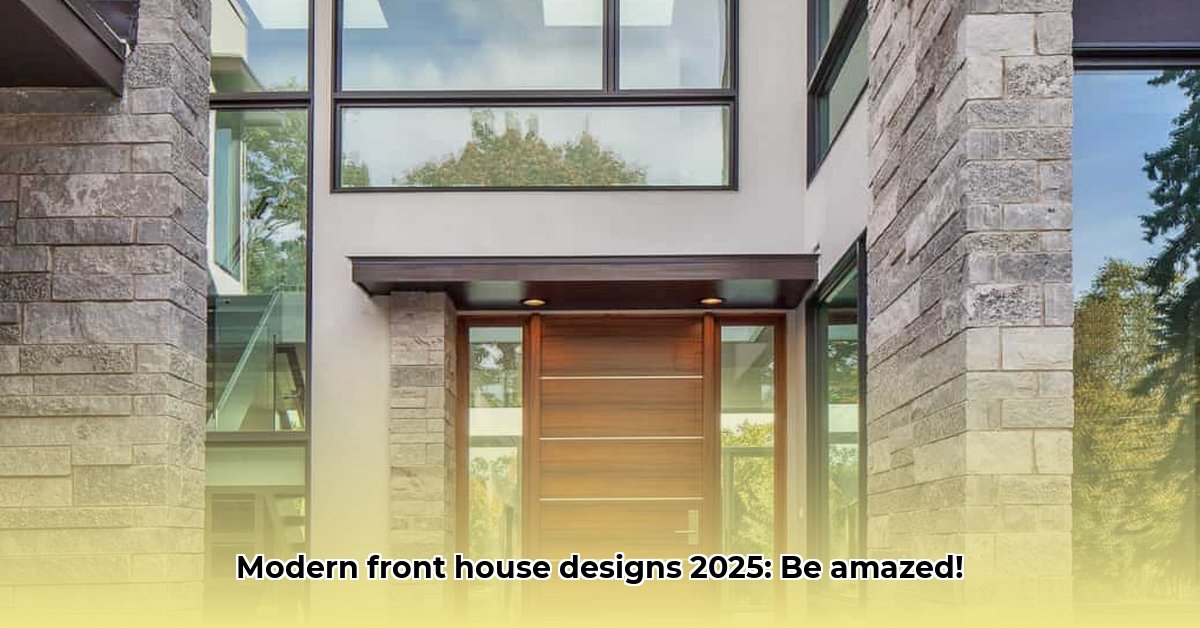Want a modern house that looks amazing and is kind to the planet? This article guides you through designing a stunning, sustainable front exterior. We’ll explore the latest trends, showcase the best materials, and provide practical tips for every step, whether you’re a homeowner, architect, or simply curious. We’ll cover eco-friendly options and ensuring your design harmonizes with your climate and style. Prepare to build the modern home you’ve always envisioned – beautiful, practical, and built to last. For more modern house design inspiration, check out this resource.
Designing a Modern Front House with 2025 Trends
Creating a modern home exterior that’s both stylish and functional is within reach. The 2025 trends reveal a captivating fusion of sleek minimalism and inviting, personalized touches. Picture clean lines enhanced by the warmth of natural materials – a winning formula!
Key Trends Shaping Modern Front House Design: A Contemporary Outlook
Bid farewell to stuffy, outdated aesthetics. Modern front house design in 2025 is defined by clean, simple lines and a sophisticated color palette. Neutral tones remain dominant, but bolder accent colors are emerging to inject personality. Envision a crisp white exterior punctuated by a vibrant teal door – a stylish statement that retains its modern elegance.
Expansive windows are paramount, both literally and figuratively, maximizing natural light exposure. They flood your home with sunlight, creating an open and airy ambiance. This openness extends to the exterior, visually connecting your home to the surroundings and promoting outdoor living. It’s a superb method to integrate your home seamlessly with its environment. The effect is striking, inviting, and unequivocally modern. Which design elements resonate most with your personal style?
Material Choices: A Deep Dive into Style and Substance for House Design
Selecting the appropriate materials is paramount for both the aesthetic appeal and longevity of your home’s exterior. Let’s delve into some popular choices:
Wood: Wood imparts undeniable warmth and natural beauty, cultivating a cozy aesthetic. It’s inviting and a timeless choice. However, bear in mind that it necessitates regular maintenance to preserve its appearance and shield it from the elements. When opting for wood, prioritize sustainably sourced options – it benefits both the planet and your peace of mind.
Stone: Stone is enduring and remarkably striking, offering unparalleled longevity. A stone facade exudes undeniable class and sophistication. Nonetheless, it ranks among the more expensive choices, and installation can be somewhat more intricate than with other materials.
Metal: Metal cladding embodies a sleek and modern aesthetic, imparting a contemporary flair that’s undeniably stylish. The advantage? It’s relatively low-maintenance. However, be mindful that it can be susceptible to dents, necessitating meticulous handling during installation.
Concrete: Concrete boasts incredible versatility – it’s a blank canvas for creativity! You can mold it into virtually any shape, crafting truly distinctive facades. Just remember that it requires proper sealing to safeguard it from moisture damage.
Here’s a quick comparison to assist your decision-making:
| Material | Pros | Cons | Approximate Cost | Sustainability Considerations |
|---|---|---|---|---|
| Wood | Warmth, natural beauty, classic appeal, renewable | High maintenance, susceptible to weathering, pest vulnerability | Medium-High | Choose sustainably sourced wood, FSC certification |
| Stone | Durable, visually stunning, high-end look, long-lasting | Expensive, complex installation, potential for environmental impact during quarrying | High | Source locally when possible, consider reclaimed stone |
| Metal | Sleek, low-maintenance, contemporary style, recyclable | Susceptible to dents, can be noisy during rain | Medium-High | Consider recycled or recyclable metals, prioritize durability |
| Concrete | Versatile, unique design possibilities, durable | Requires sealing, potential for cracking, can contribute to urban heat island effect | Medium | Look for low-carbon concrete options, use supplementary cementitious materials |
Sustainable Design: Building Green, Living Better with Eco-Friendly Materials
Sustainability isn’t merely a trend; it’s a sensible decision that can curtail reliance on non-renewable resources. It entails constructing a home that honors both the environment and your budget. Employing eco-friendly materials, such as reclaimed wood or sustainably harvested timber, conveys a positive message. Moreover, energy-efficient windows and doors substantially diminish your carbon footprint and curtail your energy expenses – a mutually beneficial scenario!
Actionable Steps for a Stunning Modern Facade: A Guide for Every Stakeholder
Let’s streamline the process, rendering it straightforward for all parties involved:
For Homeowners:
- Research and Dream: Explore diverse styles and materials online, in magazines, and by visiting showrooms. This aids in visualizing your ideal exterior.
- Get Professional Advice: Secure multiple quotes from reputable builders or contractors. Don’t hesitate to pose inquiries!
- Prioritize Energy Efficiency: Invest in energy-efficient windows and doors. These upgrades may appear costly initially, but long-term savings on energy bills will likely render them worthwhile.
- Consider Smart Home Technology: Although not indispensable, integrating smart home features like exterior lighting or security systems can augment both convenience and security.
For Architects & Designers:
- Stay Updated: Remain abreast of the latest trends in materials and sustainable design practices.
- Specialize in Sustainability: Concentrate your expertise on designing buildings that minimize their environmental impact.
- Integrate Smart Technology Seamlessly: Design projects that seamlessly incorporate smart technology without compromising aesthetics. Utilize passive design strategies to minimize energy consumption.
For Building Material Suppliers:
- Promote Green Options: Highlight and emphasize environmentally friendly products.
- Provide Design Consultation: Offer expert advice to assist customers in selecting the optimal materials for their needs and preferences.
- Invest in Innovation: Support research and development of novel and innovative sustainable building materials.
Regional Variations: Adapting Modern Design Principles
Modern design isn’t a universally applicable solution. The most effective designs adapt to their surroundings. Coastal homes frequently employ light colors and materials that withstand salt air. Mountain homes might embrace natural stone and wood, seamlessly blending with the landscape. This adaptability is pivotal in crafting a truly stunning and harmonious home. Consider local climate conditions when selecting materials to ensure durability and longevity.
Personalized Expression: Adding a Unique Touch to Modern Home Exterior
While adhering to modern principles, remember to infuse your unique personality! A vibrant front door, distinctive landscaping, or artful exterior lighting can render your home truly special. The objective is a stunning and unique house that impeccably reflects your style and taste. Don’t be afraid to experiment and personalize – after all, it’s your home! Incorporate unique architectural details like custom-designed railings or sculptural elements to express individuality.
How to Choose Sustainable Materials for a Modern Home Exterior
Key Takeaways:
- The sustainable home design market offers diverse materials with varying environmental impacts, costs, and performance.
- Responsible sourcing of traditional materials (wood, brick) remains crucial, emphasizing responsible forestry practices.
- Innovative alternatives like bamboo and recycled plastics are gaining popularity, promoting responsible production.
- Material selection depends on climate, budget, and aesthetic preferences, enhancing architectural harmony.
- Energy efficiency (insulation, windows) is paramount for sustainability, reducing energy waste.
- Locally sourced materials reduce transportation emissions, decreasing carbon footprint.
- Life cycle assessments (LCAs) are essential for accurate comparisons but often lack availability for newer, niche materials, presenting challenges in material selection.
Current Trends in Modern Exterior Design: Eco-Conscious Living
Modern exteriors often feature clean lines, minimalism, and a focus on natural materials. Think expansive windows, seamless transitions between indoors and out, and a neutral color palette punctuated by strategic accent colors. But what about sustainability? How does that factor into the design choices? Choosing sustainable materials isn’t just environmentally responsible; it can also enhance the aesthetic appeal and longevity of your home. Consider incorporating green roofs or living walls to enhance biodiversity and reduce stormwater runoff.
Diving Deep into Sustainable Materials for Eco-Friendly Construction
Let’s explore some popular options for a sustainable modern facade:
-
Reclaimed Wood: This offers unparalleled character and reduces deforestation which contributes to carbon sequestration. It’s durable and beautiful, but availability and cost vary significantly.
- Pros: Unique aesthetic, environmentally friendly, durable, reduces waste.
- Cons: Cost, limited availability, potential for pest damage (if not properly treated), may require more labor-intensive installation.
-
Bamboo: A fast-growing, renewable resource, bamboo is incredibly strong and versatile. It’s lighter than wood and requires less processing, lowering its carbon footprint. However, sourcing ethically is key. Ensure proper treatment for weather resistance.
-
Pros: Rapid growth, strength, aesthetic appeal, low processing needs, renewable and biodegradable.
- Cons: Susceptibility to moisture damage if not treated properly, cost can be high depending on sourcing, potential for off-gassing from adhesives.
-
Recycled Metal: Steel and aluminum siding offer durability, longevity, and recyclability reducing waste. They’re low-maintenance and come in various finishes. While the initial investment might be higher, they represent a wise long-term choice.
-
Pros: Durability, low maintenance, recyclable, fire-resistant.
- Cons: Higher initial cost compared to some other materials, can
- Glass Tile Shower Ideas to Create a Stunning Bathroom Space - December 7, 2025
- Glass Wall Tile Ideas for Kitchens and Bathrooms - December 6, 2025
- Glass Tile Bathroom: Create a Beautiful, Easy-Clean Space - December 5, 2025










